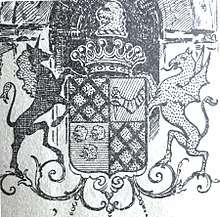Count of Ameal

Count of Ameal (Portuguese: Conde do Ameal) is a Portuguese title of nobility. It was created on June 26, 1901 by Carlos I, king of Portugal, for João Maria Correia Ayres de Campos, 1st Count of Ameal (February 5, 1847 - June 13, 1920), a prominent political figure in Coimbra and a renowned maecenas, art collector and bibliophile.[1] On the same date, Carlos I also created the subsidiary title Viscount of Ameal (Portuguese: Visconde do Ameal) for João's eldest son, João de Sande de Magalhães Mexia Salema Ayres de Campos (May 11, 1877 - December 22 1957), who would succeed his father in the comital title upon the latter's death in 1920.[2] Both titles were confirmed by king Manuel II in exile in 1920, and have since been associated.
The 3rd Count of Ameal, João Francisco de Barbosa Azevedo de Sande Ayres de Campos (his surname also graphed Aires de Campos in contemporary Portuguese orthography, February 23, 1902 - September 23, 1982), was a prolific author and historian, having signed his works with the pseudonym João Ameal.
The countship takes its name from the small hamlet of Ameal, in the outskirts of Coimbra, where the first count's paternal ancestors had their family home.
The former palace of the Counts of Ameal is a significant historic building in downtown Coimbra, and presently serves as the city's courthouse. Their mausoleum in Coimbra's Conchada cemetery, designed in the 1880s, is considered a masterpiece of Portuguese Gothic revival architecture.[3]
References
- ↑ Various authors, Nobreza de Portugal e Brasil (Lisbon, 1983), vol. II, pp. 275-277.
- ↑ Various authors, "Ameal (Condes de)", in Enciclopédia Luso-Brasileira, vol. II (Lisbon, 1965), pp. 311-312.
- ↑ Ana Lídia Pinto, Fernanda Meireles and Manuela Cernadas Cambotas, História da Arte ocidental e portuguesa, das origens ao final do século XX (Porto, 2006), p. 458.